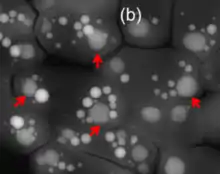Gloeomargarita lithophora
Gloeomargarita lithophora is a cyanobacterium, and is the proposed sister of the endosymbiotic plastids in the eukaryote group Archaeplastida (glaucophytes, plants, green and red algae). Gloeomargarita's relative would have ended up in an ancestral archaeplastid through a singular endosymbiotic event some 1900-1400 million years ago, after which it was recruited by the euglenids and some members of the SAR supergroup.[1][2]
| Gloeomargarita lithophora | |
|---|---|
 | |
| Scientific classification | |
| Domain: | |
| Phylum: | |
| Order: | Gloeomargaritales |
| Family: | Gloeomargaritaceae |
| Genus: | Gloeomargarita |
| Species: | G. lithophora |
| Binomial name | |
| Gloeomargarita lithophora | |
The origin of plastids by endosymbiosis signifies the beginning of photosynthesis in eukaryotes,[3] and as such their evolutionary relationship to Gloeomargarita lithophora, perhaps as a direct divergent,[2] is of high importance to the evolutionary history of photosynthesis. Gloeomargarita appears to be related to a (basal) Synechococcus branch.[4][5][6] A similar endosymbiotic event occurred about 500 million years ago, with another Synechococcus related bacteria appearing in Paulinella chromatophora.[6]
Description
G. lithophora was first isolated in 2007 from microbiolate samples taken from alkaline Lake Alchichica (Mexico). These samples were maintained in a lab aquarium and G. lithophora was isolated from biofilm that occurred within the aquarium. G. lithophora are gram-negative, unicellular rods with oxygenic photoautotrophic metabolism and gliding motility. They contain chlorophyll a and phycocyanin and photosynthetic thylakoids located peripherally. Cells are 1.1 μm wide and 3.9 μm long on average. Growth occurred in both liquid and solid BG-11 growth media, as well as in alkaline water. Optimal growth temperature is 25 °C and optimal growth pH is 8–8.5.[7]
Bioremediation
Some evidence suggests that Gloeomargarita lithophora could serve as a biological buffer to treat water contaminated with strontium, barium, or radioactive pollutants such as radium. This could be a useful application of bioremediation.[8][9][10]
References
- Strassert, Jürgen F. H.; Irisarri, Iker; Williams, Tom A.; Burki, Fabien (2021). "A molecular timescale for eukaryote evolution with implications for the origin of red algal-derived plastids". Nature. 12 (1): 1879. Bibcode:2021NatCo..12.1879S. doi:10.1038/s41467-021-22044-z. PMC 7994803. PMID 33767194.
- Betts, Holly C.; Puttick, Mark N.; Clark, James W.; Williams, Tom A.; Donoghue, Philip C. J.; Pisani, Davide (2018-08-20). "Integrated genomic and fossil evidence illuminates life's early evolution and eukaryote origin". Nature Ecology & Evolution. 2 (10): 1556–1562. doi:10.1038/s41559-018-0644-x. ISSN 2397-334X. PMC 6152910. PMID 30127539.
- Gould, Sven B.; Waller, Ross F.; McFadden, Geoffrey I. (2008). "Plastid Evolution". Annual Review of Plant Biology. 59 (1): 491–517. doi:10.1146/annurev.arplant.59.032607.092915. PMID 18315522.
- Saw, Jimmy H. W.; Schatz, Michael; Brown, Mark V.; Kunkel, Dennis D.; Foster, Jamie S.; Shick, Harry; Christensen, Stephanie; Hou, Shaobin; Wan, Xuehua (2013-10-23). "Cultivation and Complete Genome Sequencing of Gloeobacter kilaueensis sp. nov., from a Lava Cave in Kīlauea Caldera, Hawai'i". PLOS ONE. 8 (10): e76376. Bibcode:2013PLoSO...876376S. doi:10.1371/journal.pone.0076376. ISSN 1932-6203. PMC 3806779. PMID 24194836.
- Ponce-Toledo, Rafael I.; Deschamps, Philippe; López-García, Purificación; Zivanovic, Yvan; Benzerara, Karim; Moreira, David (2017). "An Early-Branching Freshwater Cyanobacterium at the Origin of Plastids". Current Biology. 27 (3): 386–391. doi:10.1016/j.cub.2016.11.056. ISSN 0960-9822. PMC 5650054. PMID 28132810.
- Sánchez-Baracaldo, Patricia; Raven, John A.; Pisani, Davide; Knoll, Andrew H. (2017-09-12). "Early photosynthetic eukaryotes inhabited low-salinity habitats". Proceedings of the National Academy of Sciences. 114 (37): E7737–E7745. Bibcode:2017PNAS..114E7737S. doi:10.1073/pnas.1620089114. ISSN 0027-8424. PMC 5603991. PMID 28808007.
- Moreira, David; Tavera, Rosaluz; Benzerara, Karim; Skouri-Panet, Fériel; Couradeau, Estelle; Gérard, Emmanuelle; Loussert Fonta, Céline; Novela, Eberto; Zivanovic, Yvan; López-García, Purificación (2017-04-01). "Description of Gloeomargarita lithophora gen. nov., sp. nov., a thylakoid-bearing basal-branching cyanobacterium with intracellular carbonates, and proposal for Gloeomargaritales ord. nov". International Journal of Systematic and Evolutionary Microbiology. 67 (3): 653–658. doi:10.1099/ijsem.0.001679. PMC 5669459. PMID 27902306.
- Blondeau, Marine; Benzerara, Karim; Ferard, Céline; Guigner, Jean-Michel; Poinsot, Mélanie; Coutaud, Margot; Tharaud, Mickaël; Cordier, Laure; Skouri-Panet, Fériel (20 April 2018). "Impact of the cyanobacterium Gloeomargarita lithophora on the geochemical cycles of Sr and Ba". Chemical Geology. 483: 88–97. Bibcode:2018ChGeo.483...88B. doi:10.1016/j.chemgeo.2018.02.029. ISSN 0009-2541. Retrieved 10 April 2020.
- Mehta, Neha; Bougoure, Jeremy; Kocar, Benjamin D.; Duprat, Elodie; Benzerara, Karim (2022-04-08). "Cyanobacteria Accumulate Radium ( 226 Ra) within Intracellular Amorphous Calcium Carbonate Inclusions". ACS ES&T Water. 2 (4): 616–623. doi:10.1021/acsestwater.1c00473. ISSN 2690-0637. S2CID 247456505.
- Mehta, Neha; Benzerara, Karim; Kocar, Benjamin D.; Chapon, Virginie (2019-11-05). "Sequestration of Radionuclides Radium-226 and Strontium-90 by Cyanobacteria Forming Intracellular Calcium Carbonates". Environmental Science & Technology. 53 (21): 12639–12647. Bibcode:2019EnST...5312639M. doi:10.1021/acs.est.9b03982. ISSN 0013-936X. PMID 31584265. S2CID 203661666.